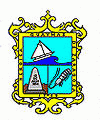Guaymas (Heroica Guaymas)
 |
The city proper is mostly an industrial port and is the principal port for the state of Sonora. The city has a well-attended annual carnival, which has been held since 1888. Nearby, San Carlos and its beaches are major tourist attractions.
Before the arrival of the Europeans, the bay of Guaymas was dominated by the Guaymas, Seri and Yaqui tribes. In 1539, two Spanish ships, the Santa Águeda and the Trinidad, arrived in Guaymas Bay. They were commanded by Francisco de Ulloa, who called the area "the port of ports."
Some small Jesuit missions were founded in the 1610s and 1620s, when Jesuits founded eight mission villages with the Yaqui. The Seri strongly opposed the European settlements and resisted fiercely until 1769.
Juan María de Salvatierra and Eusebio Kino asked for permission to evangelize the area, which was received in 1697. In 1701, Salvatierra established the Loreto mission somewhat inland of Guaymas Bay. To receive supplies by ship and evangelize the Guaymas Indians, the Jesuits founded another small mission on the bay, called San José de Guaymas. It was headed by Manuel Diaz. The Seri repeatedly attacked the San José mission, forcing it to be rebuilt several times. This mission was abandoned permanently in 1759.
In 1767, Viceroy Marqués de Croix ordered a major military offensive, the Sonora Expedition, to subdue the Seri and Pima tribes. After doing so, the Spanish colonials built an adobe fort with four towers in Guaymas under the command of Captain Lorenzo Cancio. No traces of the fort remain today, but the San José mission is marked by a church located on the road leading to Empalme. Around the same time, the colonists mapped Guaymas Bay. Guaymas was declared a city in 1769 by José Gálvez from Real de Álamos on behalf of the viceregal government. Despite the decree, no colonists settled there until the early 19th century.
In the late 18th and early 19th century, there was reportedly a single inhabitant of Guaymas, "Tio Pepe" (Uncle Pepe), said to be a drunk and a thief. At the beginning of the 19th century, the village was settled by farmers and ranchers holding large properties but having no market for their products. Farming was on a subsistence level. In 1811, commercial maritime traffic was authorized. Guaymas received the name San Fernando de Guaymas in 1820 and customs was established in 1823. Ships visited the bay intermittently, and there was one customs house. During this era, it was safer to travel by sea than by land. Guaymas became an important way point for those heading north or south. The first commercial imports came through in 1827. With the population of the area by European-Mexicans, the Guaymas natives moved to the town of Belén. They eventually disappeared as a distinct group.
The port became a municipality in 1825. During the Mexican–American War, American warships such as the Portsmouth, the Congress, the Dale and the Argos anchored near Isla Pájaros and Isla Almagre Grande. The ships fired on and captured the town, keeping it in U.S. hands from 1847 to 1848.
In the mid-19th century, Guaymas was the target of several filibusters, or unauthorized military expeditions from foreign nations, designed to foment rebellion. One was by the crew of the English sailing vessel Challenge and the French ship La Belle, commanded by Count Gastón Raousett-Boulbón, who intended to control all of Sonora. The French attacked the city on 13 July 1854, but the port was successfully defended by José María Yáñez. A firing squad executed the count soon afterwards. The national government elevated the town to city status as a reward for this action in 1859. In 1935 Guaymas received the title of "heroic city" for the same action. The municipality's formal name of Guaymas de Zaragoza was authorized in 1862. In 1865, French ships arrived to attack Republican forces, which were forced to retreat. The French occupied the city until 1866.
By 1890, the city had 10,000 residents and was somewhat prosperous. The carnival tradition it established then continues to this day.
Map - Guaymas (Heroica Guaymas)
Map
Country - Mexico
Currency / Language
| ISO | Currency | Symbol | Significant figures |
|---|---|---|---|
| MXV | Mexican Unidad de Inversion | 2 | |
| MXN | Mexican peso | $ | 2 |
| ISO | Language |
|---|---|
| ES | Spanish language |

















